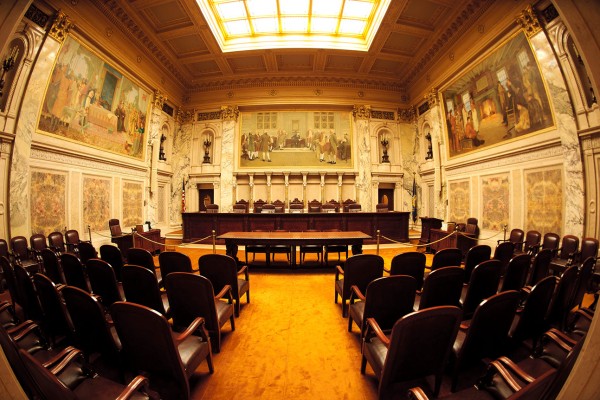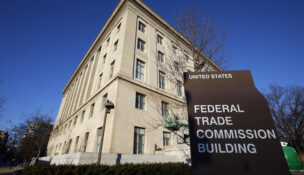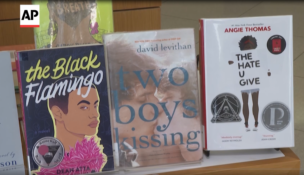Courting concurrence: 2012-13 term shows range of splits in Wis. justices’ decisions
By: David Ziemer, [email protected]//October 22, 2013//
Courting concurrence: 2012-13 term shows range of splits in Wis. justices’ decisions
By: David Ziemer, [email protected]//October 22, 2013//

The popular perception of the Wisconsin Supreme Court is that it’s sharply divided between four conservatives and three liberals.
When it comes to the daily task of deciding cases, however, the justices don’t split so easily.
According to a Wisconsin Law Journal analysis of the 45 decisions made during the court’s 2012-13 term, Chief Justice Shirley Abrahamson and Justice Ann Walsh Bradley concurred 93 percent of the time, Justices Annette Ziegler and Michael Gableman concurred 95 percent of the time, and Justice Pat Roggensack concurred with Ziegler and Gableman, respectively, 91 and 85 percent of the time.
Justices N. Patrick Crooks and David Prosser are less likely to side with any one side. Crooks most often concurred with Bradley, with whom he sided on 80 percent of cases. Prosser most frequently concurred with Roggensack, with whom he sided on 76 percent of cases.
As in years past, Abrahamson remained the least likely to concur with her fellow justices; Gableman and Ziegler in particular. Abrahamson concurred with either in only 56 percent of cases.
Abrahamson and Gableman were even less likely to concur in criminal cases, which they agreed 50 percent of the time; just slightly more than the 43 percent of cases that were unanimous.
Most likely to concur in criminal cases were Gableman and Ziegler, who agreed in 100 percent of cases.
In civil cases, the justices least likely to concur were Abrahamson and Ziegler, who agreed on 58 percent of cases. Abrahamson and Bradley were most likely to concur, agreeing on 96 percent of civil decisions.

Despite the popular 4-3 narrative, there only were six cases during the 2012-13 term in which the court divided along those lines. Three in which Abrahamson, Bradley and Crooks dissented, and three in which Gableman, Roggensack and Ziegler dissented.
Slightly more common were seven instances of 5-2 opinions with only Abrahamson and Bradley dissenting. Both justices were in the minority more often than the rest of the bench. Abrahamson dissented most often, siding with the majority only in 69 percent of cases, while Bradley was in the majority in 76 percent of cases. This marked a sharp rise from the 2010-11 term, the last year these results were compiled, in which Abrahamson and Bradley were in the majority in only 52 and 57 percent of cases, respectively. Neither justice immediately returned calls for comment.
Crooks, far from being a frequent dissenter, most often was in the majority, along with Roggensack. Both sided with the majority in 91 percent of cases. They were followed by Ziegler at 87 percent, Prosser at 84 percent and Gableman at 83 percent.
Curiously, Gableman was in the majority most often in criminal cases (100 percent), but in civil cases, he was in the majority only 70 percent of the time, the least of any justice on the court. In civil cases, Roggensack and Crooks were in the majority most often, both in 88 percent of cases.
Click the tabs below
Legal News
- FTC bans non-competes
- Gov. Evers seeks applicants for Dane County Circuit Court
- Milwaukee man charged in dismemberment death pleads not guilty
- Democratic-led states lead ban on the book ban
- UW Madison Professor: America’s child care crisis is holding back moms without college degrees
- History made in Trump New York trial opening statements
- Prosecutor won’t bring charges against Wisconsin lawmaker over fundraising scheme
- Republican Wisconsin Senate candidate says he doesn’t oppose elderly people voting
- Vice President Harris to reveal final rules mandating minimum standards for nursing home staffing
- Election workers fear threats to their safety as November nears
- Former law enforcement praise state’s response brief in Steven Avery case
- Eric Toney announces re-election bid for Fond du Lac County District Attorney
WLJ People
- Power 30 Personal Injury Attorneys – Russell Nicolet
- Power 30 Personal Injury Attorneys – Benjamin Nicolet
- Power 30 Personal Injury Attorneys – Dustin T. Woehl
- Power 30 Personal Injury Attorneys – Katherine Metzger
- Power 30 Personal Injury Attorneys – Joseph Ryan
- Power 30 Personal Injury Attorneys – James M. Ryan
- Power 30 Personal Injury Attorneys – Dana Wachs
- Power 30 Personal Injury Attorneys – Mark L. Thomsen
- Power 30 Personal Injury Attorneys – Matthew Lein
- Power 30 Personal Injury Attorneys – Jeffrey A. Pitman
- Power 30 Personal Injury Attorneys – William Pemberton
- Power 30 Personal Injury Attorneys – Howard S. Sicula











